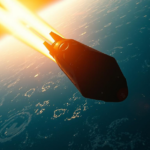How Will Sunita Williams’ Mission Impact Future Space Travel?
Sunita Williams’ mission to the International Space Station is more than just a trip. It’s a key test of new technologies that could change space travel forever. NASA and SpaceX are working together to improve life-support systems and spacecraft design.
- Who Is Sunita Williams? Meet the Pioneering Astronaut
- The Remarkable Journey: Sunita Williams’ Space Career
- Early NASA Beginnings and Training
- Previous Missions and Record-Breaking Achievements
- Preparation for the Current Mission
- Inside the Current Mission: Goals and Objectives
- Scientific Experiments Being Conducted
- Duration and Mission Parameters
- Unique Challenges Being Addressed
- NASA and SpaceX: A Groundbreaking Partnership
- Technological Innovations Showcased in Williams’ Mission
- Next-Generation Spacecraft Features
- Life Support and Habitat Advancements
- Communication Systems and Data Collection
- How Will Sunita Williams’ Mission Impact Future Space Travel?
- Advancing Astronaut Safety and Well-being
- From Low Earth Orbit to Deep Space: The Path Forward
- Conclusion: Redefining Possibilities in the Final Frontier
- FAQ
- How does Sunita Williams’ mission impact future space travel?
- What specific technological advancements are being highlighted in this mission?
- How is NASA’s partnership with SpaceX relevant to Williams’ mission?
- What kinds of scientific experiments is Sunita Williams conducting in space?
- How does Williams’ mission contribute to astronaut safety?
- What are the unique challenges Sunita Williams is addressing during her mission?
They aim to solve big challenges that have held back deep-space travel. This mission could lead to major breakthroughs in keeping astronauts safe and living sustainably in space. It could also open the door to longer missions to the Moon, Mars, and beyond.

Key Takeaways
- Williams’ mission tests systems critical for future crewed missions to Mars.
- Collaboration between NASA and SpaceX drives private-sector space innovation.
- Experiments focus on sustaining human life during long-term spaceflight.
- Data collected will refine spacecraft designs and safety protocols.
- Findings could influence Earth-based technologies and medical research.
Who Is Sunita Williams? Meet the Pioneering Astronaut
Behind the spacesuit of one of NASA’s most decorated astronauts lies a story of grit and determination. Sunita Williams, an Indian-American trailblazer, combines military precision with a passion for exploration. Before joining NASA, she served as a U.S. Naval officer and test pilot, skills that laid the foundation for her role in historic nasa astronaut missions.

| Year | Role | Achievement |
|---|---|---|
| 1998 | NASA Astronaut Candidate | Selected after 10 years as a U.S. Navy helicopter pilot and test pilot |
| 2006 | Flight Engineer | Completed Expedition 14/15, including a record-breaking 29-hour spacewalk |
| 2012 | Expedition 33 Commander | Became first woman to command the International Space Station mid-mission |
Williams’ blend of technical skill and leadership has left a lasting sunita williams astronaut impact. Her ability to thrive under pressure, whether piloting aircraft or troubleshooting in space, reflects her core strengths. Beyond her missions, she advocates for diversity in STEM, urging young women to pursue science and exploration. Her legacy as a role model underscores how her journey—from the cockpit to the cosmos—paves the way for future pioneers.
The Remarkable Journey: Sunita Williams’ Space Career
Sunita Williams went from being a naval aviator to a record-breaking astronaut. Her journey shows the hard work needed for nasa expeditions and space exploration. It’s a mix of tough training and big achievements.

“The stars remind us that curiosity drives progress,” Williams once said, reflecting on her journey. “Every mission pushes boundaries.”
Early NASA Beginnings and Training
In 1998, NASA picked Williams. She then went through tough astronaut training. She learned about robotics, spacecraft systems, and survival skills. Her time as a U.S. Navy helicopter pilot helped her focus for nasa expeditions.
Previous Missions and Record-Breaking Achievements
Her first mission was Expedition 14/15 (2006–2007). There, she did her first spacewalk. By 2012, during Expedition 32/33, she set records with 50+ hours of spacewalks—the most by a woman. She also ran a virtual marathon on the ISS while orbiting Earth, showing her physical and space exploration skills.
Preparation for the Current Mission
For her current sunita williams space mission, she trained hard. She practiced for spacecraft emergencies and learned about advanced habitat systems. This training makes sure she’s ready for the mission’s goals, like scientific experiments and testing life-support tech.
Inside the Current Mission: Goals and Objectives
The core of nasa space missions 2025 is Sunita Williams’ mission. It’s a key step for human space travel. The mission blends new science with real-world problems. It aims to prepare for future astronaut missions to the Moon and further.

Scientific Experiments Being Conducted
Important experiments are underway. They focus on human health and new technologies:
- Cellular Aging Studies: They study how space affects DNA and muscles.
- Artificial Gravity Tests: These tests use rotating pods to mimic gravity’s impact on bones.
- Plant Growth Trials: They grow lettuce in space to support long trips.
Duration and Mission Parameters
| Aspect | Details |
|---|---|
| Mission Length | 280 days in orbit |
| Orbit Altitude | 260 miles above Earth |
| Experimental Payloads | Over 50 science investigations |
Unique Challenges Being Addressed
Williams and her team face three big challenges:
- Radiation Exposure: They test new shielding for deep space.
- Equipment Reliability: Solar panels and life support systems are tested for a year.
- Human Factors: They monitor sleep and stress to improve teamwork.
“Every experiment here is a stepping stone to Mars,” says Williams. She highlights the mission’s role in shaping astronaut missions for the 2030s.
NASA and SpaceX: A Groundbreaking Partnership
The spacex and nasa collaboration has changed space travel forever. It combines NASA’s experience with SpaceX’s new technology. This mix makes missions like Sunita Williams’ possible.
This partnership brings together government know-how and private innovation. It’s pushing space exploration forward in ways we’ve never seen before.
Key areas of nasa and spacex innovations include reusable rockets and advanced life-support systems. For example, SpaceX’s Dragon spacecraft takes Williams to the ISS. It uses reusable tech that’s cheaper.
NASA focuses on the science and safety of the mission. They make sure every experiment fits into NASA’s long-term plans.

“This collaboration isn’t just about launches—it’s about unlocking humanity’s future in space.”
The benefits of this spacex and nasa collaboration are clear:
- Cost reductions through reusable rockets
- Rapid tech updates from private R&D
- Increased mission frequency for sustained research
| Past Partnerships | Modern NASA-SpaceX Model |
|---|---|
| High costs, limited launches | Cost-effective, frequent missions |
| Slow tech development | Rapid innovation cycles |
This model helps Williams’ mission succeed. It also opens the door for deeper space exploration. The spacex role in space travel is growing. It shows that public-private teams can achieve more together than alone.
Technological Innovations Showcased in Williams’ Mission
Space technology advancements on Sunita Williams’ mission are pushing the boundaries of what’s possible in space exploration. From cutting-edge hardware to smarter systems, these tools are laying the groundwork for safer, longer missions beyond Earth.

Next-Generation Spacecraft Features
Williams’ spacecraft uses next-gen spacecraft technology like autonomous docking systems that eliminate the need for manual control. These systems use AI to align and connect modules with precision. Modern propulsion systems also reduce fuel use by optimizing thrust, enabling faster trips. Key upgrades include:
- Lightweight heat-resistant materials
- Real-time system diagnostics
- Adaptive navigation software
Life Support and Habitat Advancements
“Astronaut health is the mission’s priority,” says NASA’s lead engineer. “New systems recycle 98% of water and filter air with hospital-grade efficiency.”
Improved habitat modules feature adjustable lighting to mimic Earth’s day/night cycles, reducing fatigue. Radiation shields made of composite materials block harmful cosmic rays better than ever before. Living quarters now include adjustable space-saving furniture to maximize comfort in tight quarters.
Communication Systems and Data Collection
Space travel innovation is visible in high-speed data links that transmit 4K video feeds and science data in real time. Laser-based communication systems send 10x more data than traditional radio signals, enabling seamless collaboration between the crew and ground teams. Sensors monitor everything from air quality to solar radiation, creating a data-rich environment for future mission planning.
How Will Sunita Williams’ Mission Impact Future Space Travel?
Sunita Williams’ mission is a key step in the future of space travel. It tests new systems and ways of working. NASA is learning how to keep people safe and healthy for longer space trips.

- Life Support Systems: New air and water recycling tech is being tested. It could become a must-have for future missions.
- Human Health Data: Crew health is being closely monitored. This helps plan for long trips to Mars and beyond.
- Automated Systems: AI tools are making life easier for the crew. This means future spacecraft can work on their own more.
“This mission is a proving ground for technologies that will carry humans beyond Earth orbit,” says NASA’s Human Exploration Program Director. “Every detail—from sleep patterns to equipment failures—shapes the roadmap.”
Williams’ mission is helping NASA’s Artemis program. It aims to keep humans on the moon for good. Her work also makes sure crews can get back safely during risky operations.
Her mission is teaching NASA important lessons. These lessons will shape how spacecraft are built, how long missions last, and how crews are trained. Sunita Williams’ mission is a big step towards humanity’s next big adventure in space.
Advancing Astronaut Safety and Well-being
Sunita Williams orbits Earth, testing new technologies for space travel. Innovations like health tracking and radiation shielding make space safer.

Medical teams watch Williams with wearable devices. These astronaut space travel innovations let doctors catch health problems early. This keeps the crew safe on long-duration space missions.
| Category | Innovation | Impact |
|---|---|---|
| Medical Monitoring | Real-time health sensors | Early detection of health risks |
| Psychological Support | VR therapy tools | Reduced stress during isolation |
| Radiation Protection | Advanced shielding materials | Lower exposure risks for deep-space crews |
Williams also gets support through virtual reality and video calls. These advancements in astronaut safety keep astronauts’ minds strong while they’re away.
Radiation is a big challenge. New materials in the spacecraft protect against cosmic rays. Dosimeters track how much radiation astronauts get. These could help Mars travelers in the future.
Every step forward in space research helps us here on Earth. Medical devices tested in space could improve care for patients. From wearable tech to mental health tools, space inspires solutions for all of us.
From Low Earth Orbit to Deep Space: The Path Forward
As sunita williams space exploration milestones advance, NASA’s vision extends far beyond Earth’s orbit. Current missions like Williams’ lay groundwork for nasa deep space exploration, shaping the human spaceflight future. Each experiment and protocol tested today builds a roadmap for journeys to the Moon, Mars, and beyond.

“Every mission is a stepping stone to the stars,” says NASA’s Artemis program team. “Williams’ work today ensures tomorrow’s explorers can thrive in harsher cosmic environments.”
Key steps in this journey include:
- Lunar Pioneering: The Artemis program’s return to the Moon tests habitats and tech for long-term stays, mirroring challenges faced during sunita williams space exploration missions.
- Mars Readiness: Data from Williams’ mission refines life-support systems critical for the years-long trek to Mars.
- Global Collaboration: Partnerships like NASA’s with SpaceX, showcased in Williams’ flight, will expand as international teams tackle deep-space challenges.
Challenges like radiation exposure and resource sustainability, addressed during Williams’ mission, directly inform NASA’s nasa deep space exploration blueprints. Her work proves that incremental progress—whether in recycling air or maintaining mental health—paves the way for humanity’s next giant leap.
As rockets and rovers advance, missions like Williams’ ensure that dreams of Mars colonies and asteroid mining aren’t just sci-fi. They’re the next chapter in a story humanity is writing, one experiment at a time.
Conclusion: Redefining Possibilities in the Final Frontier
Sunita Williams’ mission is more than just a step forward. It’s a giant leap into the future of space travel. She’s leading the way with next-generation space missions, including SpaceX’s spacecraft and life-support systems.
These innovations tackle big challenges like radiation and long-term living in space. They’re changing how space missions are evolving to explore deeper.
Every experiment and protocol she tests is a step forward. From medical breakthroughs to AI systems, her work will shape future space travel. It will impact Mars missions and even private space tourism.
Her collaboration with NASA and SpaceX shows how teamwork leads to discovery. It proves that space travel can meet scientific goals and human endurance. As Williams orbits Earth, she’s not just one astronaut’s story. She’s showing humanity’s path to the stars.
The next frontier isn’t just a place to go. It’s a call to innovate, work together, and dream big. Her mission shows us that every launch today is a step towards tomorrow’s cosmic achievements.
FAQ
How does Sunita Williams’ mission impact future space travel?
Sunita Williams’ mission is key for future space travel. It tests new technologies for long trips to the Moon, Mars, and more. The data will improve safety and efficiency for future astronauts.
What specific technological advancements are being highlighted in this mission?
Williams’ mission focuses on new spacecraft tech, life support systems, and communication methods. These advancements aim to make space travel safer and more comfortable for astronauts.
How is NASA’s partnership with SpaceX relevant to Williams’ mission?
NASA and SpaceX’s partnership has changed space travel. It brings together advanced tech and cost savings. This partnership makes Williams’ mission possible, showing how teamwork can speed up space exploration.
What kinds of scientific experiments is Sunita Williams conducting in space?
Williams is doing many scientific experiments in space. She studies how microgravity affects human health and international teamwork. These studies could lead to big discoveries for space and Earth.
How does Williams’ mission contribute to astronaut safety?
Williams’ mission focuses on keeping astronauts safe. It works on medical monitoring, psychological support, and radiation protection. These efforts are crucial for long space trips.
What are the unique challenges Sunita Williams is addressing during her mission?
Williams faces many challenges, like the effects of microgravity on the body. She also works on new health monitoring tech for space. Her work is essential for deep space missions.








